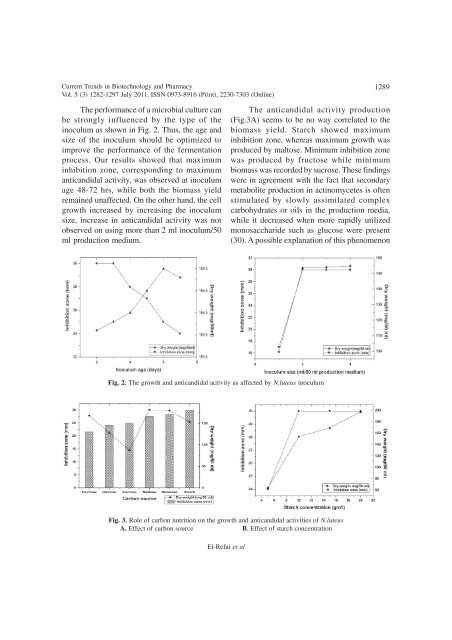full issue - Association of Biotechnology and Pharmacy
full issue - Association of Biotechnology and Pharmacy
full issue - Association of Biotechnology and Pharmacy
Create successful ePaper yourself
Turn your PDF publications into a flip-book with our unique Google optimized e-Paper software.
Current Trends in <strong>Biotechnology</strong> <strong>and</strong> <strong>Pharmacy</strong><br />
Vol. 5 (3) 1282-1297 July 2011, ISSN 0973-8916 (Print), 2230-7303 (Online)<br />
1289<br />
The performance <strong>of</strong> a microbial culture can<br />
be strongly influenced by the type <strong>of</strong> the<br />
inoculum as shown in Fig. 2. Thus, the age <strong>and</strong><br />
size <strong>of</strong> the inoculum should be optimized to<br />
improve the performance <strong>of</strong> the fermentation<br />
process. Our results showed that maximum<br />
inhibition zone, corresponding to maximum<br />
antic<strong>and</strong>idal activity, was observed at inoculum<br />
age 48-72 hrs, while both the biomass yield<br />
remained unaffected. On the other h<strong>and</strong>, the cell<br />
growth increased by increasing the inoculum<br />
size, increase in antic<strong>and</strong>idal activity was not<br />
observed on using more than 2 ml inoculum/50<br />
ml production medium.<br />
The antic<strong>and</strong>idal activity production<br />
(Fig.3A) seems to be no way correlated to the<br />
biomass yield. Starch showed maximum<br />
inhibition zone, whereas maximum growth was<br />
produced by maltose. Minimum inhibition zone<br />
was produced by fructose while minimum<br />
biomass was recorded by sucrose. These findings<br />
were in agreement with the fact that secondary<br />
metabolite production in actinomycetes is <strong>of</strong>ten<br />
stimulated by slowly assimilated complex<br />
carbohydrates or oils in the production media,<br />
while it decreased when more rapidly utilized<br />
monosaccharide such as glucose were present<br />
(30). A possible explanation <strong>of</strong> this phenomenon<br />
Fig. 2. The growth <strong>and</strong> antic<strong>and</strong>idal activity as affected by N.luteus inoculum<br />
Fig. 3. Role <strong>of</strong> carbon nutrition on the growth <strong>and</strong> antic<strong>and</strong>idal activities <strong>of</strong> N.luteus<br />
A. Effect <strong>of</strong> carbon source B. Effect <strong>of</strong> starch concentration<br />
El-Refai et al













